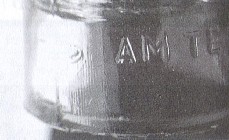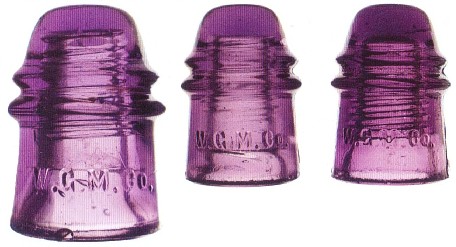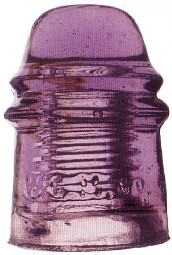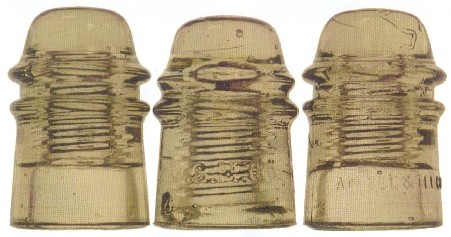They Had To!
by Mike Miller
Reprinted from "Crown Jewels of the Wire", November 2002, page 32
Dear Research Division Editor
Crown Jewels
In a letter in the February 1972
Crown Jewels, a certain Chris Hedges of Kansas City, Missouri mentions having an
unembossed sun-colored amethyst CD 121 with tiny crosshatching on the skirt that
was similar to that on a sun-colored amethyst AM TEL & TEL CO toll. Chris
assumed that they had been made by the same company and asked for ideas from the
readership with no apparent response. This letter is a belated attempt to answer
Chris's query.
The faint crosshatching is obviously intentional and was engraved upon the
molds for one of two possible reasons. To provide a better gripping surface for
the lineman placing it onto a pin or to prevent the still soft insulator from
turning in the mold as the threading mandrel was being withdrawn during
manufacture just as bars, dots or stars were used by other manufacturers for
this reason.
|
Cross hatching on skirt typical of W.G.M. CO. produced AM TEL & TEL CO
tolls. |
 |
The similarity between the two arise because both the embossed and the
unembossed insulators were made in the same molds. A careful examination of the
subtle differences in the dome shape will reveal a four mold set originally
unembossed but later having Am TEL & TEL CO with its rather singular
geometric ampersand engraved.  The four molds (see pages 34-35) may be
identified as follows:
The four molds (see pages 34-35) may be
identified as follows:
MOLD I - Narrow, flat dome. Abrupt transition upper wire ridge to dome.
Embossing 2-1/2" long. The "&" slopes right.


Progressive deterioration of molds and embossings help date W.G.M.CO.
production. The early molds (left) were clean surfaced with crisp, clear
embossing and a medium red color.

Crude molds and weak embossing were typical near the end of W.G.M. CO. toll
manufacture. The lavender purple shade of that era matches the coloration of the
W.G.M.CO. production of the AM TEL & TEL CO. tolls.

 |
|
"Worm" parallel track left side of dome. (Mold II) |
"Lehr kiss" above "TEL" (Mold III)
|
 |
|
Leaner (Mold IV) |
Harelip (Mold IV) |

The similarity of color and manufacturing techniques between the CD 121 AM.
TEL. & TEL. CO. tolls to known W.G.M. CO. products is significant.

MOLD II - Intermediate dome. Rounded transition upper wire ridge to dome.
3/8" & 7/8" diameter circles on dome. Embossing 2-3/8" long.
The "&" is vertical. Low bar in "A". The "v"
in "M" is high.

MOLD III - Broad, squarish dome. Abrupt transition upper wire ridge to dome.
Embossing 2- 5/16" long. The" &" is vertical.

MOLD IV - Intermediate dome. Abrupt transition upper wire ridge to dome.
There is a series of circles on dome from 1" to 1-1/8" in diameter.
Embossing is 2-7/16" long. The" &" is large and slopes left.

But who was the maker? Though the evidence is purely circumstantial, I believe
that a strong case can be made that these pieces were a product of the Western
Glass Manufacturing Co. of Denver, Colorado. They have most often been found in
the states of Colorado, Idaho, Montana, New Mexico, Utah and Wyoming.
In the spring of 1907, J. P. Morgan gained financial control of the American
Telephone and Telegraph Company. Morgan promptly reinstalled Theodore Vail as
President of A. T. & T. Now began the great period of standardization of the
Bell Associated Companies, which in this intermountain West were the Rocky
Mountain Bell Telephone Company (Utah, Idaho, Montana and Wyoming) and the
Colorado Telephone Company (Colorado and New Mexico).
A common standard of business organization, construction and operating
practices was quickly put in place. Also, now came an enlarged role for Western
Electric Company.
In addition to being the manufacturer of switchboards,
telephones and cable, Western Electric became the quartermaster of the Bell
System. It would now arrange for the bulk purchase of such things as poles,
cross arms, wire and insulators. And, of course, set standards which suppliers
would have to meet. No longer could the Colorado Telephone Company purchase
insulators from the local glass plant. If they or Rocky Mountain Bell needed
insulators, they must now order them from Western Electric. THEY HAD TO!
WESTERN UNION SPECIFICATIONS
|
Specification E-300 1
May 24, 1907
STANDARD INSULATOR, PONY INSULATOR AND TRANSPOSITION INSULATOR
The quality of materials used and the methods of manufacture, handling and shipment shall
be such as to ensure for the finished insulators the properties
and finish called for in these specifications. The manufacturer must make sure
that all material and work is in accordance with the specifications before the
insulators are delivered. The Western Electric Company is to have the right to
make such inspections and tests as it may desire of the materials and of the
insulators at any stage of the manufacture. The inspector of the Western
Electric Company shall have the power to reject any material or insulator which
fails to satisfy the requirements of these specifications. Inspection shall not,
however, relieve the manufacturer from the obligation of furnishing satisfactory
material and sound, reliable work. Any unfaithful work or failure to satisfy the
requirements of these specifications that may be discovered by the telephone
company on or before the receipt of the finished insulators shall be corrected
immediately upon the requirement of the telephone company, notwithstanding that
it may have been overlooked by the inspector.
Where maximum and minimum
dimensions are shown the dimensions shall be within the limits specified. Where
limits are not shown the dimensions shall be appropriate.
- - - - - - - - - -
GENERAL - The drawings and specifications are intended to include all
instructions necessary for the manufacturer to guide him in his work. They are
intended to cooperate with and supplement each other so that any details
indicated in one and not in the other shall be executed the same as if indicated
in both.
L-3001-1
|
|
Figures upon the drawings are to be followed in preference to scale
measurements.
All material and workmanship unless otherwise specified shall be
of the best grade.
MATERIAL - All insulators shall be made of colorless or transparent light
green glass.
PONY INSULATOR - The pony insulator shall be of the style and
dimensions shown on drawing #84-E-57.
STANDARD INSULATOR - The Standard
insulator shall be of the style and dimensions shown on drawing #84-E-59.
TRANSPOSITION INSULATOR - The transposition insulator shall be of the style and
dimensions shown in drawing #84-E-58.
MARKINGS - Each insulator or part thereof
shall bear such initials or other designating marks, as may be specified by the
telephone company.
THREAD - The pony and standard insulators shall have the
standard thread as shown on drawings #84-E-57 and #84-E-59. The threads shall be
well centered in the insulators so that when in place on a standard pin, the pin
will not touch the inside of the petticoat.
The transposition insulator shall
have the standard as shown on drawing #84-E-58. The threads shall be well
centered in both the top and bottom glass so that, when in place on a standard
transposition pin, the pin will not touch the inside of the petticoat of the
lower glass nor the petticoat of the top glass touch the lower glass.\
The
threads of all insulators shall be smooth and of uniform pitch and such that the
insulator gauge shown on drawing #57-E-26 can easily be screwed into the
insulator up to the shank.
L-3001-2
|
|
In each case, when in this position on the gauge, no insulator shall be
noticeably loose, nor show a perceptible amount of play or wobbling.
FINISH -
The surface of the insulator shall be smooth and even conforming closely to the
outlines of the moulds, and giving the insulators the dimensions required.
The
insulators shall have a finish in accordance with the best commercial practice
ensuring, as far as possible, freedom from flaws, cracks, blow holes, sharp
edges and other defects.
| Drawings - The following drawings and specifications of the Western Electric
Company form a portion of these specifications. |
| Drawing #84-E-57 |
Pony Insulator |
|
Drawing #84-E-59 |
Standard Insulator |
| Drawing #84-E-58 |
Transposition Insulator |
|
Drawing #84-E-2 |
Insulator Gauge |
| Specification for the Inspection of Glass
Insulators |
WESTERN ELECTRIC COMPANY
C.E. Scribner,
Chief Engineer.
|
* Western Electric Specifications courtesy of Clarice Gordon.
W.G.M. CO. was faced with the prospect of losing their best insulator
customers. Western Electric is not going to buy the toll W.G.M.CO. had been
making -- the shape is not right, the embossing is wrong, the surface is rough
and there are too many deformities. W.G.M.CO. would have to invest in some new
molds. THEY HAD TO!
And, it was about time! W.G.M.Co.'s four toll molds over the
past six years, had been run to destruction. The molds leaked glass, they had
become rusty and scaly, they had been repaired several times and the embossing
had eroded to the point it was barely legible.
In addition to new molds,
W.G.M.CO. would have to do something about their quality control. Open bubbles,
underpours, rough edges, leaners, etc. would not be accepted. (See page 35.)
Better training of the boys on the insulators press! Discard those insulators
which do not meet spec! THEY HAD TO!
This progression of damage to the
W.G.M.Co. molds permits one to roughly date the colors W.G.M. Co. made. The
earliest, when the molds were fresh and new is a medium red purple trending with
increasing damage to royal purple and finally a very pretty light lavender
purple. (See page 33.) It is in this exact shade that the W.G.M. Co. AM. TEL
& TEL.COs are usually found.
They have also occasionally been found in the
unsolarized or partially solarized W.G.M. Co. colors of straw, peach and pink.
It was a straw AM. TEL. & TEL. Co, dug by a bottle digger friend in the fall
of 1998, which got me interested in these and began this study.
While the AM.
TEL. & TEL. CO molds were new the manufacturing process was not. They were
still made the only way W.G.M. Co. knew -- hand-gathered and hand-pressed. So,
even with increased inspection, these can be found with worms on the dome,
harelips, leaners and lehr kisses. They fluoresce a wild, fuzzy yellow green
when exposed to ultra violet light as do nearly all Denvers.
The late William L. Brookfield, in a Crown Jewels of the Wire article
December, 1999, relates some of his father's trials with Western Electric. At
some point, the agent suggested that Brookfield make clear glass as a competitor
was doing.
"Father took a number of (his) green glass insulators and put
them in a line. Then he placed the same number of clear glass ones also in a
line. He put live steam on both sets. Most of the clear glass insulators cracked
but not a single one of the green glass ones."

The "chubby" style of a Brookfield toll made for
Western Electric's
distribution in purple and in aqua.

Shop number "2" on the top of the purple and
aqua Brookfield
manufactured tolls.
Perhaps Mr. Brookfield relented as there are Brookfield-made purple AM. TEL.
& TEL. CO. tolls as well. We might recall that in this period, the second
half of the first decade of the 20th century, Brookfields only competition in
the domestic manufacture of insulators were Hemingray and W.G.M. Co.
Well, Chris Hedges, if you are still out there in insulatordom, I hope this
helps.
| 